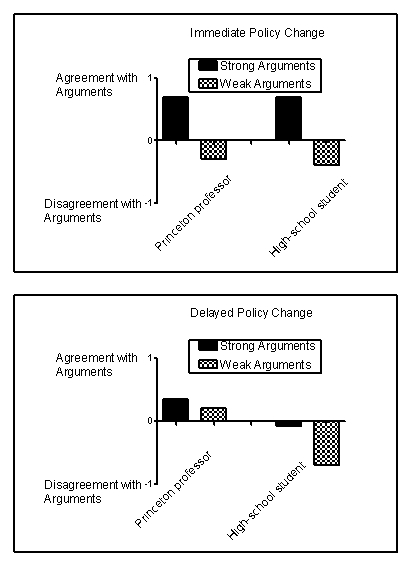Scenario II
The following scenario contains fabricated results consistent with the following study:
Petty, R. E., Cacioppo, J. T., & Goldman, R. (1981) . Personal involvement as a determinant of argument-based persuasion. Journal of Personality and Social Psychology, 41, 847-855.
Every day, consumers are exposed to scientifically based sales, marketing, and public relations strategies designed to influence purchasing decisions, change opinions, or win votes. One common sales strategy is the foot-in-the-door technique, a method that involves first making a smaller request that consumers are likely to grant and then following it by a larger request. Another common strategy is the door-in-the-face technique, which involves making an unreasonably large request that consumers will reject and then following it by a smaller request. When persuasion is necessary, it usually takes one of two forms: heuristic persuasion involves an appeal to habits or emotion, and systematic persuasion involves an appeal to facts and reason. Often, people will rely more on heuristics-simple short-cuts or "rules of thumb"-to make decisions instead of systematically weighing the evidence.
Petty and colleagues (1981) investigated some of these techniques in college students listening to arguments in favor of their college requiring an institution-level comprehensive final examination for graduation. Some students were led to believe that, if adopted, this policy would take place right away, and some were led to believe that the change would take place in a decade. In addition, some of the students were led to believe that they were listening to an argument from a Princeton professor, and others were led to believe that they were listening to an argument from a high-school student. Finally, some students heard strong arguments in favor of the policy, and some heard weak arguments. Thus, the experiment arranged six groups of students. For example, one group of students heard strong arguments from a high-school student about a far-removed policy change. Figure 13.1 shows fabricated results illustrating the major findings of this experiment.
Figure 13.1 
-(Scenario II) In the Petty et al. (1981) experiment, the purpose of manipulating the time that the policy would go into effect was to:
Definitions:
Radioactive Sulfur
A form of sulfur that contains isotopes capable of emitting radiation, often used in scientific research to trace chemical and biological processes.
Radioactive Phosphorus
A radioactive isotope of phosphorus, often used in medical and biological research to trace and study the behavior of phosphorus-containing compounds in organisms.
Protein Coat
The protective layer of proteins surrounding the nucleic acid of a virus, also known as a capsid, which helps in the attachment and penetration of host cells.
X-ray Diffraction
Using the diffraction of X-rays, this method unveils the molecular structure by interpreting the scattering pattern that emerges when X-rays pass through a crystalline substance.
Q11: _ is both a theory of personality
Q24: First-year college students tend to have weaker
Q25: Among college students, _ tend to show
Q29: PET imaging has revealed that auditory hallucinations
Q41: Scoring high on extraversion is correlated with
Q52: A _ can be described as a
Q65: Which statement best illustrates underestimating the variability
Q95: The dictator who hears only the praises
Q132: Which statement about the relationship between neuroanatomy
Q178: An error associated with stereotyping is that